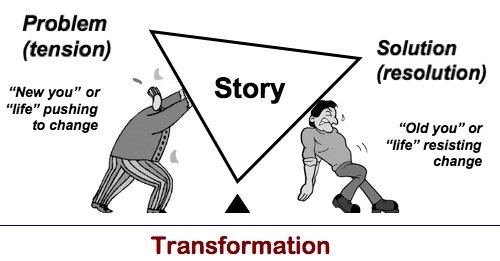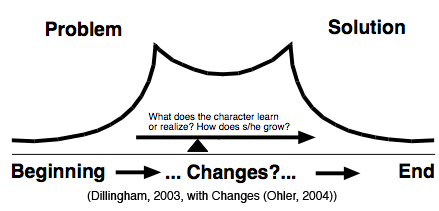QUOTES ON STORYTELLING
“Telling weak stories with technology is like giving a bad guitar player a bigger amplifier.”
“Writing is the primary tool used to plan and create a digital story. The saying “if it ain’t on the page then it ain’t on the stage” is just as true for digital storytelling as it is for theater and movies.”
— Jason Ohler, digital storytelling expert
“Having a clear idea of possible beginnings, middles and ends, is a big help for me. But if the story is strong enough within you, you’ll be pressurised a certain way and the story will tell itself. Beginnings and middles and ends are a very good way of trying to work it out in advance. Don’t do anything on a whim or because you want to feel really fancy – it just doesn’t work. Lies are soon found out. You can’t fool an audience.”
— Shane Connnaughton (co-wrote the Oscar nominated screenplay for My Left Foot)
THE ART OF STORYTELLING
The following selections were excerpted from “The Art of Storytelling,” by Jason Ohler. These selections will help you identify how to further develop your final digital storytelling project. What Ohler calls “story mapping” is essentially the first step towards writing a synopsis.
The three elements of the “story core” should be familiar to you by now, as these are the essential elements of any storytelling plot, whether fictional or “based on a true story.”
The section on story mapping describes how a plot might unfold across the separate acts of a story: Act I: beginning; Act II: problem, changes, solution; Act III: end. The three-act structure has been a staple of storytelling for thousands of years, but the second act is always the longest, so some storytellers find it helpful to break that act down into three mini-acts.
The Story Core: Three Basic Elements

(1) The central challenge that creates the story’s tension and forward momentum. This can be a question, a problem, an obstacle, an opportunity or a goal that needs to be addressed by the main character in the story.The challenge creates tension that gives the story its forward momentum, which in turn produces listener involvement. FYI: the main character can be anything from a rock, to a group of animals, to a student, to, in some cases, the audience itself.
(2) Character transformation that facilitates the response to the challenge. Transformation is difficult and is often resisted, a portrayed in the picture below. Transformation is the essential change that a character needs to undergo to address the challenge, obstacle or opportunity. Sometimes the transformation occurs at the end, and, rarely, at the beginning. But it is usually most powerful when it occurs in the middle and facilitates the response to the challenge. Typically, change is a struggle. Either “life” or the “old you” pushes back as new circumstances or a “new you” struggles to emerge. If change comes too easily in a story, the audience disengages.
(3) The response to the challenge that resolves the tension and leads to story closure. The character addresses the challenge made possible by the transformation. This can mean solving a mystery, slaying a dragon, reaching a goal, applying new academic knowledge or learning processes, overcoming an obstacle… anything that addresses the challenge, resolves the tension and leads to closure. Closure by no means implies a happy ending, just a resolution of events.
To me, the story core is about emergence, as portrayed in this image. Here you see an “old me” and “new me” battling with each other. The old me struggles not to change, to maintain the status quo and thus deny the call to adventure and to transformation. The new me knows that his survival ultimately depends on his transformation.
Story Mapping

The map shows the five essential story elements. Note that the story core is at the heart of the map:
Beginning. The [storyteller’s] “call to adventure.” Somehow, normal life is suspended and an adventure begins.
Problem. Life pushes against the main character in the story by presenting him or her with a problem to solve, an obstacle to overcome, or a mission to accomplish. The problem creates the tension that must be resolved. It sets the mood, and makes story listeners want to know what is going to happen next.
Changes. The main character transforms in some significant way, such as learning something important, becoming more skilled, mature or courageous, or developing personal insight and understanding. In great stories the character’s transformation is so great that we, the listening audience, feel transformed as well. However, this is the simple explanation. I devote an entire chapter in my book to transformation because it can be a complex topic. For example, with documentaries sometimes the primary transformation is in audience members, as we learn about a situation that has an effect on us. With academic new media stories, transformation occurs by students showing what they have learned. See the chapter for much more on this topic.
Solution. Often due to the transformation, the character can now solve the problem, overcome the obstacle or accomplish the mission. Sometimes the change and solution don’t come until the end of the story.
End. The end brings the story to “closure.” Note that closure does not necessarily mean “a happy ending.” It simply means that the problem in the story has been resolved.
